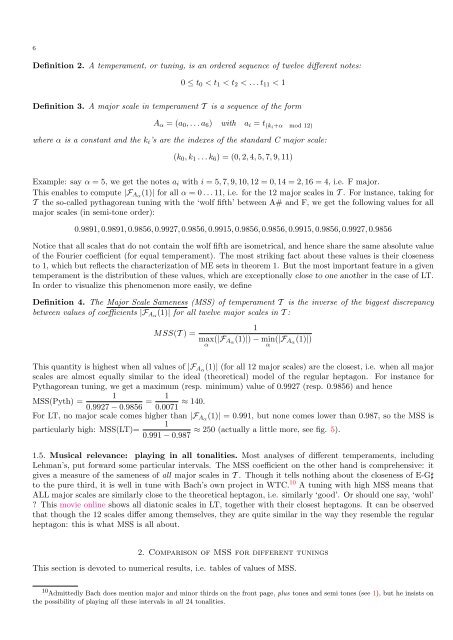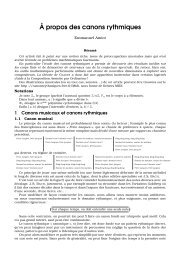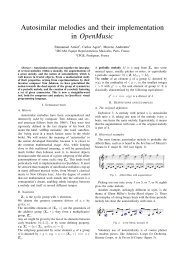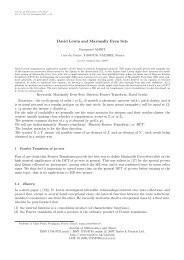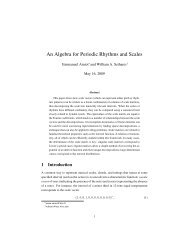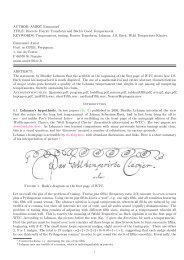Emmanuel Amiot Modèles algébriques et algorithmes pour la ...
Emmanuel Amiot Modèles algébriques et algorithmes pour la ...
Emmanuel Amiot Modèles algébriques et algorithmes pour la ...
You also want an ePaper? Increase the reach of your titles
YUMPU automatically turns print PDFs into web optimized ePapers that Google loves.
6<br />
Definition 2. A temperament, or tuning, is an ordered sequence of twelve different notes:<br />
0 ≤ t0 < t1 < t2 < . . . t11 < 1<br />
Definition 3. A major scale in temperament T is a sequence of the form<br />
Aα = (a0, . . . a6) with ai = t (ki+α mod 12)<br />
where α is a constant and the ki’s are the indexes of the standard C major scale:<br />
(k0, k1 . . . k6) = (0, 2, 4, 5, 7, 9, 11)<br />
Example: say α = 5, we g<strong>et</strong> the notes ai with i = 5, 7, 9, 10, 12 = 0, 14 = 2, 16 = 4, i.e. F major.<br />
This enables to compute |FAα(1)| for all α = 0 . . . 11, i.e. for the 12 major scales in T . For instance, taking for<br />
T the so-called pythagorean tuning with the ‘wolf fifth’ b<strong>et</strong>ween A# and F, we g<strong>et</strong> the following values for all<br />
major scales (in semi-tone order):<br />
0.9891, 0.9891, 0.9856, 0.9927, 0.9856, 0.9915, 0.9856, 0.9856, 0.9915, 0.9856, 0.9927, 0.9856<br />
Notice that all scales that do not contain the wolf fifth are isom<strong>et</strong>rical, and hence share the same absolute value<br />
of the Fourier coefficient (for equal temperament). The most striking fact about these values is their closeness<br />
to 1, which but reflects the characterization of ME s<strong>et</strong>s in theorem 1. But the most important feature in a given<br />
temperament is the distribution of these values, which are exceptionally close to one another in the case of LT.<br />
In order to visualize this phenomenon more easily, we define<br />
Definition 4. The Major Scale Sameness (MSS) of temperament T is the inverse of the biggest discrepancy<br />
b<strong>et</strong>ween values of coefficients |FAα(1)| for all twelve major scales in T :<br />
MSS(T ) =<br />
1<br />
max<br />
α (|FAα(1)|) − min<br />
α (|FAα(1)|)<br />
This quantity is highest when all values of |FAα(1)| (for all 12 major scales) are the closest, i.e. when all major<br />
scales are almost equally simi<strong>la</strong>r to the ideal (theor<strong>et</strong>ical) model of the regu<strong>la</strong>r heptagon. For instance for<br />
Pythagorean tuning, we g<strong>et</strong> a maximum (resp. minimum) value of 0.9927 (resp. 0.9856) and hence<br />
1<br />
MSS(Pyth) =<br />
0.9927 − 0.9856 =<br />
1<br />
≈ 140.<br />
0.0071<br />
For LT, no major scale comes higher than |FAα(1)| = 0.991, but none comes lower than 0.987, so the MSS is<br />
particu<strong>la</strong>rly high: MSS(LT)=<br />
1<br />
≈ 250 (actually a little more, see fig. 5).<br />
0.991 − 0.987<br />
1.5. Musical relevance: p<strong>la</strong>ying in all tonalities. Most analyses of different temperaments, including<br />
Lehman’s, put forward some particu<strong>la</strong>r intervals. The MSS coefficient on the other hand is comprehensive: it<br />
gives a measure of the sameness of all major scales in T . Though it tells nothing about the closeness of E-G♯<br />
to the pure third, it is well in tune with Bach’s own project in WTC. 10 A tuning with high MSS means that<br />
ALL major scales are simi<strong>la</strong>rly close to the theor<strong>et</strong>ical heptagon, i.e. simi<strong>la</strong>rly ‘good’. Or should one say, ‘wohl’<br />
? This movie online shows all diatonic scales in LT, tog<strong>et</strong>her with their closest heptagons. It can be observed<br />
that though the 12 scales differ among themselves, they are quite simi<strong>la</strong>r in the way they resemble the regu<strong>la</strong>r<br />
heptagon: this is what MSS is all about.<br />
2. Comparison of MSS for different tunings<br />
This section is devoted to numerical results, i.e. tables of values of MSS.<br />
10 Admittedly Bach does mention major and minor thirds on the front page, plus tones and semi tones (see 1), but he insists on<br />
the possibility of p<strong>la</strong>ying all these intervals in all 24 tonalities.


